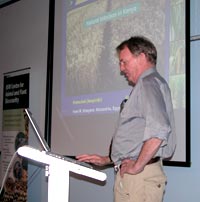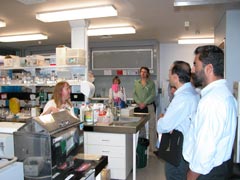
'Stem rust is back' says world expert

Australian wheat growers have been warned that one of the world’s most devastating diseases of wheat, stem rust, “is back”.
Keynote speakers at a symposium on rust diseases held in Sydney last week said that a virulent new stem rust known as Ug99 posed a threat to wheat crops worldwide.
According to an international organisation set up to combat the disease, the Global Rust Initiative (GRI), “the amount of stem rust now in the world might be very small, but there is about to be a lot more”.
The GRI’s facilitator, Dr Rick Ward, told the meeting: “Ug99 defeats the resistance that has protected most of the world’s wheat for 40 years.
“The stem rust population is about to expand enormously. The necessary factors are there for this to be an epidemic disease”, he said.
Ug99 was the major topic at a symposium organised by the NSW Centre for Animal and Plant Biosecurity, a collaboration between the NSW Department of Primary Industries and the University of Sydney.
The disease was first detected in Uganda in 1999 and last month Ug99 was found in the highlands of Yemen on the Arabian Peninsula.
Dr Ward said the GRI predicts Ug99 will move along a known pathway towards Syria and Iraq.
”The potential risk area is home to one billion people and produces 117 million tonnes of wheat – 20 per cent of the world crop – a year. It is worth US$16.4 billion annually.”
In Australia, national rust control strategies have been in place since a major rust outbreak in 1973. The NSW Department of Primary Industries (DPI) takes an active part in national cereal rust control through disease monitoring and screening and breeding for resistance.

However, participants made it clear that Ug99 is a concern to Australian wheat growers.
Director of the University of Sydney’s Plant Breeding Institute, Professor Robert Park, said that 75 Australian wheat cultivars were evaluated in 2005 for resistance to Ug99.
Seventeen of these cultivars were found to be susceptible to Ug99 as well as to Australian stem rust pathotypes.
Since then, Ug99 has shown that it is changing. There are recent reports that Ug99 is able disarm a resistance gene known as Sr24. This is an important gene for resistance in Australian wheat varieties.
Professor Park said that if Ug99 was able to disarm Sr 24, then a further 12 Australian wheat varieties would be susceptible.
This would bring the total number of susceptible Australian varieties to 29.
According to DPI Principal Research Scientist, Dr Colin Wellings, controlling a pathogen the magnitude of Ug99 “was something no one agency could handle”.
“Breeding for resistance needs to be sustainable (with reduced chemicals), national, collaborative, and undertaken in an international context”, he said.
Dr Park said the strong national program in place in Australia had been very successful in developing rust-resistant cultivars, thereby pre-empting local mutations.
“In 1985, it was estimated that rust resistance breeding saved the Australian grains industry $289 million a year.
“Sustained rust control by genetic resistance is achievable, provided there is national support”, he said.
Participants in the symposium identified a number of areas where research investment was required to help deal with the stem rust threat.
They included:
- Succession planning to ensure that the necessary expertise is available to the research and development community, given the imminent retirement of key personnel,
- A need to address the absence of critical plant science containment facilities in Australia, and
- A need to maintain effective national and international pathogen monitoring.
Dr Ward commented that there is a very small community internationally “that knows anything about stem rust”.
The symposium also addressed the issue of climate change, which Dr Ward said was likely to change the location and dynamics of persistent rust populations.
Email:

